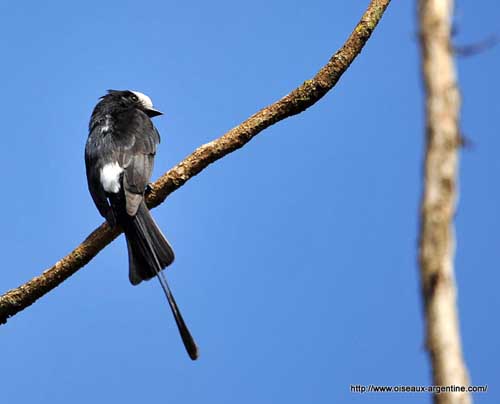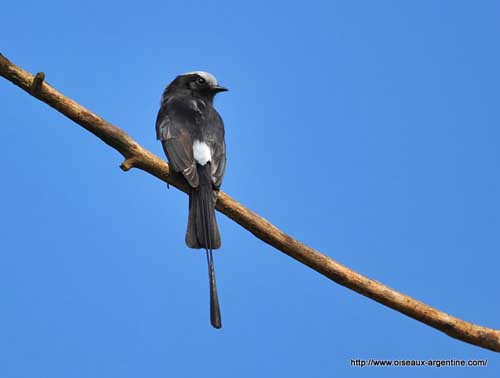
Long-tailed Tyrant
Colinia colonus
Passeriforme Order – Tyrannidae Family
BIOMETRICS:
Length: Male: 23-28 cm – Female: 18-22 cm
Weight: 15-18 g
DESCRIPTION:
The Long-tailed Tyrant is the only member of genus Colonia. This is a cavity nester in spite of its long tail.
The adult male has black plumage except on forehead, forecrown and rump which are white. The belly is greyish-black.
The tail shows two elongated central tail feathers (up to 13 cm beyond the other rectrices). These elongated feathers become slightly broader towards the tip.
The short, wide bill, legs and tiny feet are black. The eyes are dark brown to blackish.
The female is similar but slightly paler and greyer with mottled white belly, darker crown and shorter tail streamers.
The juvenile is sooty grey with pale grey belly. The crown is bordered by fine whitish stripe. The central rectrices are broader and barely projecting.
Fr: moucherolle à longs brins
All : Weißkappen-Schleppentyrann
Esp: Mosquero Colilargo
Ital: Tiranno codalunga
Nd: Langstaarttiran
Sd: Långstjärtstyrann
Port: Viuvinha
Photographers :
Marc Chrétien
MURINUS
Patrick Ingremeau
TAMANDUA
Philippe and Aline Wolfer
OISEAUX D'ARGENTINE
Text by Nicole Bouglouan
Sources :
HANDBOOK OF THE BIRDS OF THE WORLD Vol 9 - by Josep del Hoyo - Andrew Elliot - David Christie - Lynx Edicions - ISBN: 8487334695
BirdLife International (BirdLife International)
Arthur Grosset's Birds (Arthur Grosset)
Wikipedia, the free encyclopaedia
XENO-CANTO – Sharing Birds sounds from around the world

We can find five subspecies which differ in intensity and extent of white on head and back, and body and bill size.
VOICE: SOUNDS BY XENO-CANTO
The Long-tailed Tyrant often moves the long tail while calling or singing. During the breeding season, it utters some “prrri, bi-bibi” during the courtship chases.
Usual calls include a soft rising “tuweee” or “wheeet” during which the tail is flicking up. These calls can be repeated 2-3 times and rapidly.
The song by male is a longer “twee-la, twee-la, twee-la”. It utters a musical “druu” with whipping of the tail. During interaction between two birds, they give sibilant “chip”.
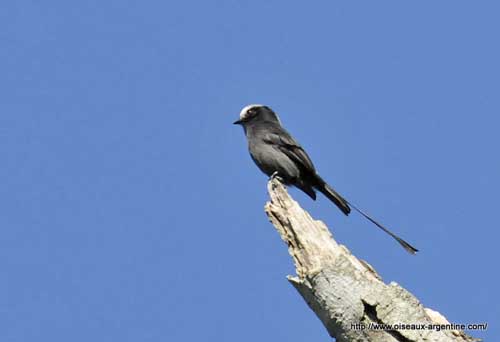
HABITAT:
The Long-tailed Tyrant frequents the borders of tropical humid forest and edges of gallery forest. It can be found in recent clearings, active or abandoned plantations with dead snags and tree trunks, forested borders along water and generally areas with snags. It often occurs below 1200 metres, but sometimes higher.
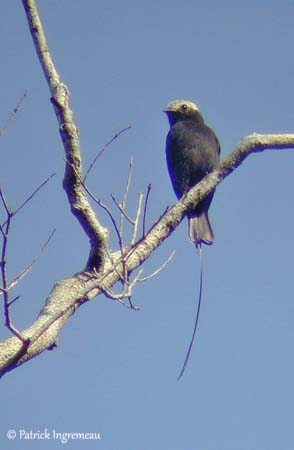
RANGE:
The Long-tailed Tyrant is found in Honduras and Nicaragua, W Colombia, W Ecuador, NE Peru, SE Venezuela and the Guianas, N Bolivia, C and E Brazil, E Paraguay and NE Argentina.
The species is mostly resident in its range, but the southernmost populations leave their breeding areas during the austral winter.
BEHAVIOUR:
The Long-tailed Tyrant feeds on insects, and mainly hymenopterans and coleopterans. This species feeds on stingless bees such as sweatbees of genus Trigona which are living in tree holes in many parts of the range.
It hunts from prominent perches such as exposed branches or dead snags. Its aerial strategy consists on rapid sallies to catch a prey. Then, it returns to the same parch or nearby. It often forages in pairs or family groups.
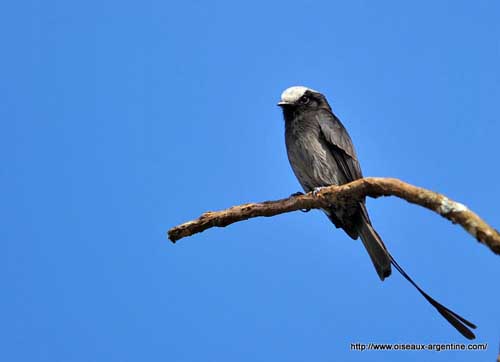
This species is mostly resident, and the pairs maintain a small permanent territory all year round, usually in the vicinity of their favourite nest-site, snag or tree trunk. This nest-site is strongly defended against other cavity nesters. They rarely venture farther.
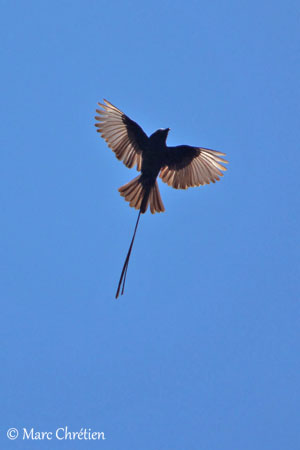
Both mates perform some mutual chases during the breeding season. The pair of elongated rectrices is more ornamental than aerodynamic, and the aerial displays enhance this peculiar feature. In addition, the bird often flicks its tail up and down while calling and singing.
FLIGHT:
The Long-tailed Tyrant has a pair of flat and narrow, elongated central rectrices. These feathers are placed in the centre rather than on the sides of the tail, suggesting more ornamental use than aerodynamic function.
However, it may fly rapidly when performing sallies from perches. The wings are rounded but fairly large, involving some sustained velocity in flight.
REPRODUCTION:
The breeding season varies throughout the range, from March-July in Central America, Colombia and Venezuela, to October-November in Argentina.
The Long-tailed Tyrant is a cavity nester, using holes in dead snags and tree trunks for nesting. It may use an abandoned woodpecker’s hole. The nest is placed inside the cavity. This is a thick mat made with a mix of leaf rachises. It may be very high, between 8 and 30 metres above the ground in dead snag or burnt trunk, usually located in open area.
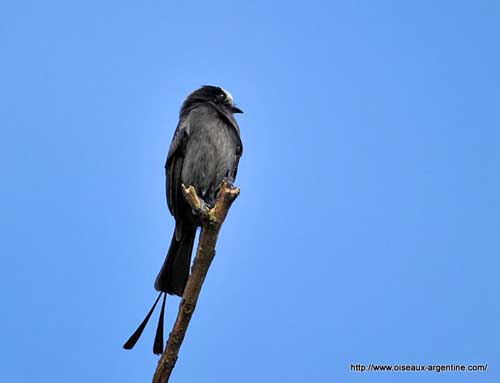
Before the laying, the female occupies the cavity and roosts in the nest during about one week. Then, she lays 2-3 whitish eggs and incubates during 13-14 days. The chicks are fed by both adults, and fledge about 15-20 days after hatching.
DIET:
The Long-tailed Tyrant feeds mainly on bees and wasps, and especially on stingless sweatbees of genus Trigona. The bird perches high on exposed branches and performs rapid sallies to snatch the prey before to return to the same perch.
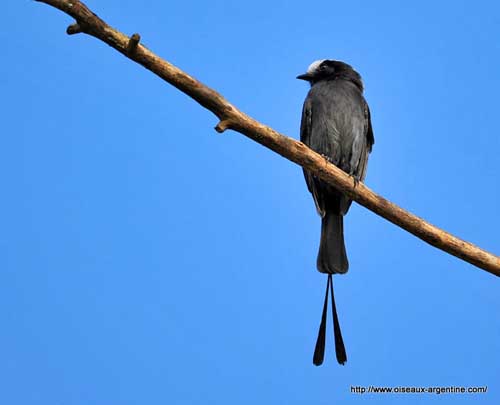
PROTECTION / THREATS / STATUS:
The Long-tailed Tyrant is fairly common to common according to the range. It may be tolerant of converted habitats, but it needs suitable dead snags and tree trunks with cavities for nesting, and nearby bees’ colonies for feeding.
This species is visible in several protected areas and parks throughout the range, and is evaluated as Least Concern by BirdLife International.
